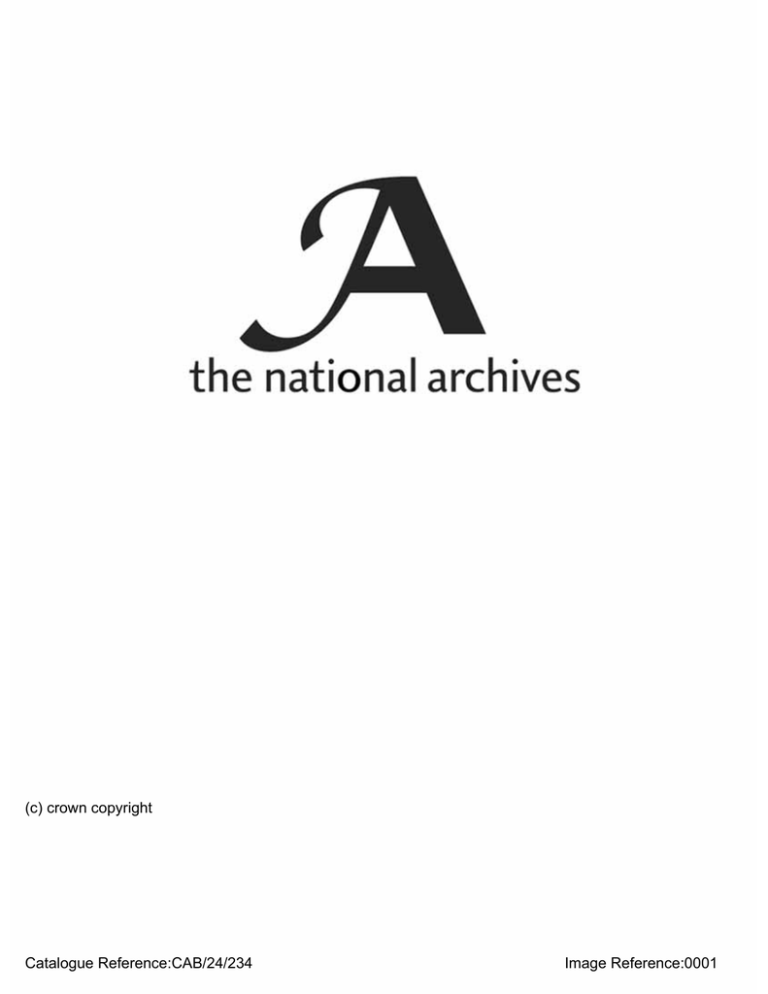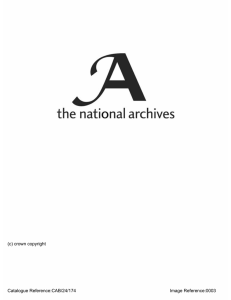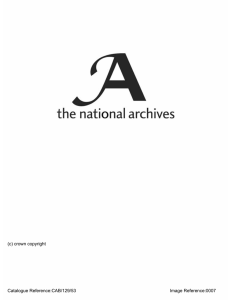(c) crown copyright Catalogue Reference:CAB/24/234 Image Reference:0001
advertisement

(c) crown copyright Catalogue Reference:CAB/24/234 Image Reference:0001 Printed for the Cabinet. SECRET. November 1932. Copy No. ' 3 C P . 386 (32). CABINET. HOUSING MEMORANDUM POLICY. BY T H E M I N I S T E R OF HEALTH. A D E C I S I O N is needed on housing policy. After the war we took the bull of housing shortage by the horns, with a general subsidy. For some time we have been trying to let go, and finding it difficult. I believe that, with the fall in building costs and in the rate of interest, the long-awaited moment has come when we can do so with safety. To get an adequate and regular supply of small houses of the type required, we need conditions under which private enterprise and capital can find profitable employment in their supply. With the fall in money and costs, those conditions are now realised. There is no obvious reason why private enterprise and capital should not now provide the supply. There is evidence that the chief thing that prevents them is the competition of subsidised houses built by the local authorities. The right course, then, not for financial reasons only, but to promote the building of houses for the working classes, is to stop the general subsidy. A t the same time, it is not possible to cease all State help for housing. W e cannot leave slum clearance wholly to private enterprise. Slums are an evil that need the more immediate effort that State help alone can secure. The proposal is. then, to concentrate State-aid for housing on slum clearance, and to intensify administrative effort in that direction. Future subsidies would be given, not for any small house, but only for a house built to replace a slum dwelling. Financial considerations are not set in the forefront of this proposal, but they are, of course, very relevant. The effect of the proposals is to save the Exchequer an increase of charges for housing of approximately £200.000 in the first year, £400,000 in the second, £600,000 in the third and so on. In the following memorandum, the reasons for the proposed course are expanded and particulars are given of the measures proposed. The present rates of Exchequer subsidy and the provision made for housing­ subsidies in the current estimates are shown in the appendix. 1. Provision of New Houses. (i) A s regards ordinary housing, for which the principal subsidy is that given under the Act of 1924, three-bedroomed houses of an economical type can now be built without any subsidy to let at rents comparable with the rents of houses provided hitherto with the aid of subsidy from the Exchequer and the local authorities. On this and other grounds the Committee on Local Expendi­ ture, in their recent Report, have recommended, though not quite unanimously, the termination of subsidy for ordinary housing under the Act of 1924. The figures of building costs, subsidies and rates of interest at different periods since 1925 are set out and analysed in that Report and the Committee's conclusion is that— " the average all-in cost of houses provided during the quarter ended the 30th June last was £380, and that the economic rent of such a house (with money at 4 per cent, and repayment of debt in sixty years) is 8s. Qd. a week after providing £5 10s. per annum for repairs, maintenance, voids. [7870] n &c. When the scheme of subsidy under the Act of 1924 was initiated a rent of 7s. del. was contemplated with the aid of subsidies. In other words a position has been reached where only del. a week separates the possible unsubsidised rent of a house built to-day from the subsidised rent required at the inception of the scheme We do not consider that there is justification in maintaining the expensive and complicated mechanism of a subsidised scheme for the sake of a figure which, on the basis of a cost of £380 per house and interest at 4 per cent., amounts to no more than 9d. a week." The calculation is undoubtedly well based. The Committee also point out that if the rate of interest were to fall to 3-i per cent, the 9d. difference between the economic weekly rent and the rent regarded as reasonable in 1924 would be reduced to 3d.; and the same result would follow on a reduction of £30 in the average capital cost of a house, while a reduction of £45 in the capital cost would wipe out the difference entirely. They further suggest that by the exercise of more rigid economy in the layout, planning and specification of the houses the number of authorities who can to-day provide houses at a lower cost than £380 would be considerably increased. As a matter qf fact, there are cases in which it is being done at a substantially lower figure. In recent months non-parlour houses with two or three bedrooms have been built in four urban areas at a building cost of less than £260, and in a number of other urban areas at a building cost of less than £300. The cost of land, roads and sewers is usually estimated at an average of £70, and is often as low as £50. A total figure of £330 is, therefore, now attainable in favourable circumstances in urban areas. As to future costs, the Committee point out that experience has shown that when on previous occasions housing subsidies have been abolished or reduced, a substantial fall in building prices has followed. (ii) These figures provide strong financial grounds for the immediate termination of the subsidy under the Act of 1924. At the same time it is necessary to consider the probable effect of such a decision on the total production of small houses, whether by private or municipal enterprise, and on the amount of unemployment in the building industry (to the limited extent, between 20 per cent, and 10 per cent., to which this depends on small house building). Private enterprise already provides without subsidy nearly two-thirds of the total output of houses below £26 rateable value in the Provinces and £35 rateable value in the London area. There is no reason why the termination of subsidy should decrease this output. On the contrary, it is likely to be substantially increased. On this point the Committee say :— '' We consider it essential that the supply of what is still in many areas in urgent demand should, at the earliest practicable moment, be divorced from considerations of subsidy. For at present private enterprise claims that it is deterred from meeting this demand by fear of subsidised competition, while, on the other hand, Public Authorities may naturally be deterred, under existing financial conditions, by consideration of the charge which the provision of new houses would throw on the taxes and the rates," and in their summary of conclusions, the Committee say :— " We think it probable that the combined effect of the saturation in some districts of the demand for houses for sale, the withdrawal of subsidised competition in houses to let, the general lowering of interest rates on gilt­ edged investments, and the reduction in building costs will be to induce the private builder and—still more important—the private investor to return to the provision of houses for letting to the working classes. To this end we consider that immediate policy should be directed." I believe these recommendations to be fully supported by the facts of the present position. (iii) There is evidence that there are now large accumulations of private capital ready to seek an outlet in the provision and ownership of working-class dwellings if the competition of subsidised building is withdrawn. A number of local authorities have recently been approached by private capitalists desirous of buying existing municipal housing estates, and important proposals have been submitted to me by the Building Societies whereby their large funds would be made available, on terms, for the provision of new houses for sale or letting to working-class occupiers. The main proposal made by the Building Societies is that a scheme should be authorised under which they would advance 90 per cent, of the valuation of houses erected by builders subject to a three-party guarantee (to be shared between the Exchequer, the local authority and the Building Society) of the difference between this percentage and the percentage (70 per cent.), which would normally be advanced by the Building Society under its rules. This proposal will need careful consideration and discussion with the local authorities, but I am not unhopeful that this or some similar arrangement could be made whereby a large supply of capital might be made available on advantageous terms. (iv) A t the same time until private enterprise gets into its stride it is probable that a number of authorities will find it necessary themselves to provide houses to let without subsidy, and I should propose to approve such proposals where it is shown that there is a clear need for the houses and that private enterprise is unable to meet it. (v) Such is the general outline of the proposals submitted in regard to ordinary housing. While we should rely on private enterprise to provide the main supply of working-class houses in the future, it will remain the duty of the local authorities, as before the war, to watch the position with care, and be prepared to supplement the action of private enterprise by themselves providing houses of an economical type without subsidy from the taxes or the rates where the need is shown to exist. 2. Slum Clearance. (i) The statistics of house building since the war show the magnitude of the effort which has been made to overcome the national shortage. During the inter­ censal period from 1921 to 1931 the number of dwellings was increased by 1.704,530, and the number of dwellings per thousand of population, which was 215 before the war and 212 in 1921, was increased to 244 in 1931. These figures suggest that in many districts the shortage must have been overtaken or at least largely reduced, and the problem is now more of a local character. On the other hand, only the surface of the slum problem has been scratched; the hope that the large provision of new houses would lead to a process of filtering up from the slums has in practice been falsified, and it is submitted that the limited resources of the State and of the local authorities should now be concentrated on the work of slum clearance. The energies of local authorities and their officers, if no longer preoccupied to the same extent as hitherto with the provision of ordinary new houses, can be diverted in this direction. I attach much importance to this husbanding of the resources and concentration of the energies of local authorities for the most urgent part of the problem, slum clearance. The problem of the slum is one of health rather than housing, and the concentration of the national effort on its solution is in no sense inconsistent with the proposal to leave ordinary new housing, so far as possible, to private enter­ jDrise. To proceed now to concentrate effort and subsidy on slum clearance is a natural sequel to the decision made last January to restrict subsidy to the smallest and most urgently needed type of house. The present proposal is the second of two steps in a process of concentrating effort and expenditure on the purpose­ most needed. (ii) The question of the rate of subsidy for slum clearance was considered by the Committee on Local Expenditure, who recommended that— a reduction should be made in the existing Exchequer subsidy and rate­ contribution commensurate with the substantial reductions in the cost o f building and rates of interest which have occurred since 1930." This recommendation would justify a reduction of nearly £1 per person displaced in the normal Exchequer subsidy of £2 5s.. and of 10s. per house in the existing rate contribution of £3 15s. per house. Nevertheless. I am reluctant on general grounds to reduce the subsidy for slum clearance at the same time as the cessation of the general subsidy. Although justified by financial conditions, the reduction must reduce the inducement to [7870] n2 the local authorities to take up slum clearance actively, and make it more difficult to stimulate them to the necessary effort. It will be better, I suggest, to retain the higher subsidy for a time, to encourage the local authorities to transfer their housing energies to slum clearance. An opportunity will occur in a years time of reconsidering the rate of subsidy, when the attention of local authorities has ibeen attracted, and their energies applied, to the matter. I propose, therefore, to make no reduction in the subsidy for slum clearance for the present. 3. Rural Housing. The Housing (Rural Workers) Acts, 1926 and 1931, provide an Exchequer subsidy towards the cost of reconditioning rural cottages, and the Committee on Local Expenditure recommend that this subsidy should be continued and that greater use should be made of the facilities which the Acts make available. I should propose to accept the Committee's recommendation. The Housing (Rural Authorities) Act, 1931. made provision for special -additional Exchequer assistance to be granted on the recommendation of an Advisory Committee appointed under the Act (of which the Right Honourable Sir J. Tudor Walters is Chairman) towards the provision of houses for agricultural workers and others of a similarly low rent-paying capacity in agricultural parishes and rural districts whose Councils satisfied certain conditions and made application before the 30th November. 1931. The Committee on Local Expenditure recommended that applications for further houses in excess of the maximum of 2,000. to which the Government last year restricted the scheme, should not be entertained. The Advisory Committee have already promised to entertain applications in respect of 1,717 houses, which must be regarded as commitments, and it is submitted that no further commit­ ments should be entered into. The effect of terminating subsidy under this Act and the Act of 1924 should be to encourage that greater use of the Housing (Rural Workers) Acts which the Committee on Local Expenditure have recommended. 4. Consolidation of Housing Subsidies. The Committee on Local Expenditure recommend that, when further grants of subsidy under the Act of 1924 are discontinued, provision should be made for a comprehensive scheme of consolidation covering subsidy under the Housing Acts of 1919, 1923 and 1924. I should propose to adopt the Committee's recommendation by taking powers in the Act to effect such a consolidation in consultation with local authorities at the right time. 5. Rent Restriction. The Cabinet will remember that nearly a year ago I submitted a memorandum on Rent Restriction ( C P . 305 (31)), and authority was given for the preparation of a Bill following the lines of the recommendations of the Inter-departmental Committee which was presided over by Lord Marley, and which made its report in July 1931. It is necessary to consider the general question of housing and housing subsidies in relation to the Government policy as to the restriction of rents of privately owned houses. The ultimate aim in the latter case is the complete removal of restriction, and in the former the complete abolition of subsidies. We can, for the present, progress only by stages in each case, and the proposals made in this memorandum (as"the Committee on Local Expenditure point out), are not inconsistent with a Rent Restriction Bill on the lines-of the Marley Committee's Report. Indeed, whatever uncertainties attend the period of transition from subsidy to private enterprise, and some uncertainties there must be, are an additional reason for ceasing the decontrol of the smallest class of house for the period. v6. Financial Considerations. The steady growth of the cost to the Exchequer and to local authorities of ;the special arrangements made to meet the shortage in housing accommodation since the war has^become a matter of very serious concern. The annual charge is now approximately £13^ millions, and is increasing at the rate of approximately £350,000 a year. It will not begin to decline materially until 1940, even ii' the provision for new subsidies is stopped now. Every additional house approved for subsidy at the present ordinary rate involves an Exchequer capital liability of £150, payable as an annuity of £7 10s. per annum for 40 years. The cost to local authorities, though much less substantial, is also serious, and will continue for a similar period. As already indicated, the Exchequer housing commitment is likely to increase by about £350,000 a year if the present rate of approvals for new houses (which has fallen considerably of late) may be assumed to continue. Of this, £275,000 is in respect of the Act of 1924 and £75,000 in respect of the Act of 1930. The latter represents about 6,000 houses per annum. In present circumstances I do not think w e can expect, whatever stimulus we apply, to reach the high water mark of 27,000 houses per annum contemplated by the five-year programme provided for by the Act of 1930. The whole number of houses built for replacement of slums since the Armistice under legislation prior to the Act of 1930 did not exceed 13,000. I f the annual rate should increase to 12,000 houses, the effect on the Exchequer of the present proposal would be as follows :— r Retardation of annual commitment under the 1924 Act Acceleration of annual commitment under the 1930 Act Net retardation of annual commitment ... ... £ 275,000 75,000 200,000 As the commitments for new houses are for a period of 40 years, this retardation is cumulative—200,000 in the first year, 400,000 in the second. -600,000 in the third, and so on. 7. Scotland. A separate memorandum dealing with Scottish policy is being circulated by the Secretary of State. I agree with the adaptations of policy to Scottish conditions which he proposes. There has always been a " l a g " in Scottish housing policy, in relation to English. The differences in Scottish conditions, referred to by the Secretary of State, appear to me to justify a continuation of the lag for another step, in the manner suggested. 8. Authority is sought for— (a) Negotiation with the Building Societies and the local authorities on the lines indicated in paragraph f. I (\\\) ­ (b) Introduction of legislation for terminating subsidy under the Acts of 1924 and 1931, and for consolidation of subsidy as indicated in paragraph 4. (Initialled) November 17, 1932. E. PL Y . APPENDIX. I. T H E following are the housing subsidies available under the different Acts under which new commitments are still being incurred :— Housing (Financial Provisions) Act, 1924. £7 10s. per house per annum for forty years (in agricultural parishes, £11). Housing (Rural Workers) Acts, 1926 and 1931. One half of the annual cost incurred by local authorities in providing assistance spread over twenty years. Housing Act, 1930. Where rehousing is in cottages £2 5s. per person for forty years (in agricultural parishes, £2 10s.). Where rehousing is in tenements of more than three storeys on cleared sites or on sites costing more than £3,000 per acre, £3 10s. per annum per person for forty years. Housing (Rural Authorities) Act, 1931. In addition to the subsidy of £11 payable under the Act of 1924. an amount of special assistance to be determined on the recommendation of an Advisory Committee appointed under the Act. I I . The following provision is made for housing subsidies in the estimates for the current year :— 1. 2. 3. 4. 5. 6. Housing Town Planning. &o, Act, 1919 Housing, &c, Act, 1923 ... Housing (Financial Provisions) Act, 1924 Housing (Rural Workers) Acts, 1926 and 1931 Housing Act, 1930 Housing (Rural Authorities) Act. 1931 o £ 6,835,000 2,594,000 3,700,000 16,000 250,000 5.000




